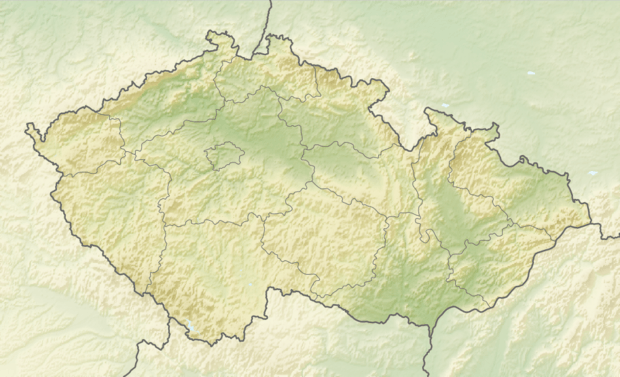Kroměříž
Kroměříž ([ˈkromɲɛr̝iːʃ] (![]()
Kroměříž | |
|---|---|
Town | |
.jpg) Town square seen from the Kroměříž Castle tower | |
 Flag  Coat of arms | |
| Nickname(s): Athens of Hanakia | |
 Kroměříž Location in the Czech Republic | |
| Coordinates: 49°17′56″N 17°23′35″E | |
| Country | Czech Republic |
| Region | Zlín |
| District | Kroměříž |
| Founded | 1260 |
| Government | |
| • Mayor | Jaroslav Němec |
| Area | |
| • Total | 50.97 km2 (19.68 sq mi) |
| Elevation | 201 m (659 ft) |
| Population (2019-01-01[1]) | |
| • Total | 28,816 |
| • Density | 570/km2 (1,500/sq mi) |
| Time zone | UTC+1 (CET) |
| • Summer (DST) | UTC+2 (CEST) |
| Postal code | 767 01 - 767 04; 767 07 |
| Website | www.mesto-kromeriz.cz |
| Official name | Gardens and Castle at Kroměříž |
| Criteria | ii, iv |
| Reference | 860 |
| Inscription | 1998 (22nd session) |
The city has traditionally held an international festival of military brass music[2] and the international festival of sacred music FORFEST [3] On the outskirts of the city there is the Agricultural Research Institute Kroměříž (formerly the Research Institute of Grain, etc., founded in 1951), which is engaged in research and breeding of cereals.[4]
History
In the Middle Ages, there was a ford across the Morava and the crossroads of the Amber and Salt Roads (which was the actual continuation of the famous Silk Road).The first written record of Kromeriz dates back to 1110. On the Arab map, known as Tabula Rogeriana, the city is referred to as Agra.[5]
The settlement, inhabited by Slavs since at least the 7th century, was founded in 1260 by Bruno von Schauenburg, bishop of Olomouc. Bruno chose Kroměříž to become his see and he also made his castle the centre of his dominion, which consisted of more than 60 vassals from all over Moravia. Kroměříž is referred to as a market village in a document by Přemysl Otakar II from 1256, but by 1266 it was already referred to as a town. Bruno established what was to become the famous Archbishop's Palace. The town was badly damaged in the Thirty Years' War, was plundered twice by Swedish troops (1643 and 1645), and after this the Black Death took its toll on the population. Bishop Karl II von Liechtenstein-Kastelkorn rebuilt the city and the palace after that war. The Constitutive Imperial Congress sat in Kroměříž in 1848.
Notable people
- Karel Josef Adolf (1715–1771), Czech painter, restorer and valet in the service of Olomouc bishops
- Renata Berková (born 1975- ), triathlete
- Heinrich Ignaz Biber (1644–1704), composer and violinist
- Filip Chytil (born 1999), ice hockey player
- Alexej Čepička (1910–1990), communist politician
- Václav Jan Frierenberger (1759–1823), general of the Napoleonic Wars
- Miloslav Gajdoš ( born 1948-), composer and double bassist
- Gabriela Gunčíková (born 1993), singer
- Pavel Hapal (born 1969), former football player, now coach
- Andrea Tögel Kalivodová (* 1977), opera singer
- Jaroslav Koutecký (1922–2005), chemist
- František Kožík (1909–1997), writer
- Boris Krajný (born 1944 - ), pianist
- Augustin Krist (1894-1964), Czechoslovak soccer referee
- Karel Kryl (1944-1994), musician
- Robert Land (1887–1942), film director
- Miloš Macourek (1926–2002), poet, playwright, screenwriter
- Jan Milíč z Kroměříže (died 1374), ideal predecessor of Jan Hus; initiated the practice of preaching in the Czech language in Prague.
- Martin Miller, (1899–1969), actor
- Tomáš Netopil (born 1975 - ),conductor and violinist
- Pavel Novotný (born 1973-), soccer player
- Edmund Pascha (1714–1772), preacher, organist and composer
- Michal Peprník (born 1960-), professor of American literature
- Milan Pitlach (born 1943-), Czech architect and photographer
- Karel Prager (1923–2001), architect
- Jan Rypka (1886-1968), orientalist, translator, professor of Iranology and Turkology at Charles University, Prague.
- Josef Silný (1902-1981), football player; played at the 1934 FIFA World Cup, where Czechoslovakia reached the final.
- Pepča Stejskal (born 1945) graphic designer, poet, surrealist
- Ferdinand Stolička (1838–1874), traveler, geologist, naturalist, the first Czech in the Himalayas
- Ludvík Svoboda (1895–1979), army general and president
- Pavel Štercl (born 1966-), Czech and Czechoslovak water slalom and canoeist
- Petr Štercl ( born 1966-), Czech and Czechoslovak water slalom and canoeist
- Max Švabinský (1873-1962), painter
- Václav Talich (1883–1961), conductor
- Petr Uličný (born 1950-), soccer player and later soccer coach
- Pavel Josef Vejvanovský (1639/1640–1693), baroque composer
Twin towns — sister cities
Kroměříž is twinned with:[6]
References
- "Population of municipalities of the Czech republic". Czech Statistical Office. Retrieved 2019-04-30.
- Kuncová, Jarmila (2011-09-04). "V Kroměříži obnovili festival vojenských hudeb" (in Czech). Retrieved 2019-09-12.
- "Festival Forfest Czech Republic". www.forfest.cz. Retrieved 2019-09-12.
- "VUKOM - Neco z historie". Archived from the original on 2012-03-13.
- "Zajímavé střípky z historie - Geografie a kartografie | Islam Cz". 2011-11-04. Archived from the original on 2011-11-04. Retrieved 2019-09-12.
- "Partnerská města" (in Czech). Město Kroměříž. Retrieved 2019-08-22.
External links
| Wikimedia Commons has media related to Kroměříž. |
